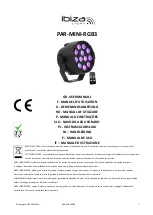
SERVICE LEVEL MAINTENANCE
33
The output line of the tank is also equipped with
a strainer screen. The strainer protects the pump
from larger sized impurities being introduced into the
hydraulic system and to the pump. If flow to the pump
is slow or restricted, the strainer may be blocked with
impurities. Flow to the pump will also be restricted if
the hydraulic fluid is too cold to flow properly through
the strainer screen. To service or clean out the strainer
screen, the pump supply hose and the tank fitting must
be removed from the tank.
DRAINING HYDRAULIC SYSTEM
The drains for the hydraulic reservoir are located on the
bottom surface of the tank. Be prepared to safely catch
and contain approximately 35 liters (9.5 gallons) of
hydraulic oil. Do Not Use The Hydraulic Pump To Pump
The Hydraulic Oil Out Of The System.
The hydraulic system is self–bleeding and does not
normally store or retain any pressure when the pump
is not in operation. However, in the event of failure of
certain components, hydraulic pressure can be trapped
in the system. Before servicing any component, check
for any remaining hydraulic pressure.
● Allow time for the hydraulic oil in the system to cool.
● Disconnect the quick release fittings from the spinner
assembly.
● Do Not Start Engine To Use
The Hydraulic Pump To Pump The Hydraulic Oil Out Of
The System.
Some hydraulic oil will always remain in the system
and in the components. Always be prepared to properly
catch and contain any remaining hydraulic oil when
servicing the hydraulic system components.
TO AVOID SERIOUS INJURY,
Be Aware of the Possibility of Trapped High
Pressure in the Hydraulic System.
DO NOT USE HANDS TO CHECK FOR LEAKS!!
WEAR SAFETY GLASSES!!
HYDRAULIC PUMP
The hydraulic pump is mounted directly to the crankshaft
on the engine. The pump begins to operate as soon as
the engine is started. The pump is a gear pump type.
The pump has two hydraulic hoses attached, the 1” hose
is the hydraulic fluid supply hose from the reservoir. The
other hose, a 1/2” inch, is the hydraulic pressure output
line which is routed to port “P” on the manifold valve
block.
If the pump is not operational, check the following:
● Pump drive coupling between engine and pump is
inoperable.
● Strainer screen in tank output fitting is blocked,
partially blocked or damaged.
● Hydraulic fluid wrong for temperature range.
Hydraulic fluid too cold to properly flow to pump or
hydraulic fluid is to hot to operate motors.
● Hydraulic fluid supply hose collapsing during
operation. Fluid supply hose kinked or twisted.
● Twisted, kinked, or restricted pressure output hose
on pump.
● Hydraulic fluid level in tank too low.
● Damage or worn pump. Excess internal leakage in
the pump.
MANIFOLD VALVE BLOCK
The manifold valve block contains a relief valve, the
conveyor belt speed control, and the S1 and S2 solenoid
valve bodies that control hydraulic flow to the conveyor
belt motor and the spinner assembly motors.
Relief Valve:
Located in port “RV” in the block. The relief
valve is installed to prevent hydraulic pressure from
becoming too high in the system. The relief valve is a
non–adjustable type valve that routes excess pressure
back through the filter to be returned to the reservoir.
The relief valve does not have any user serviceable parts.
If the valve is malfunctioning, it will need replacement.
Conveyor Belt Speed Control:
Located in port “FC” in
the block. The conveyor belt speed control controls the
speed of the conveyor belt by regulating the amount of
hydraulic flow and pressure to the motor.
The conveyor belt speed control valve does not have
any user serviceable parts. If the valve is malfunctioning,
it will need replacement.
S1 and S2 Solenoid Valve Bodies:
Located in ports
“S1” and “S2” in the block. These valves control the
hydraulic flow to the hydraulic conveyor belt motor (S2)
and the spinner wheel hydraulic motors (S1). Both S1
and S2 are electrically operated valves, controlled by
the switch on the hand held ON/OFF control box.
The valves are a “normally open” type valve allowing the
hydraulic flow to bypass the spinner wheel motors and
the conveyor belt motor. When the hand–held switch
is in the ON (
I
) position, the solenoid is activated.
Electrical activation closes the valves and directs the
hydraulic flow to the motors.
The solenoids are a replaceable service part. The valve
bodies do not have any user serviceable parts. If the
valves are malfunctioning, they will need replacement.
Refer to the “Electrical Systems” maintenance section in
this manual for information about servicing the electrical
connections or the hand-held ON/OFF control box.
WARNING
















































